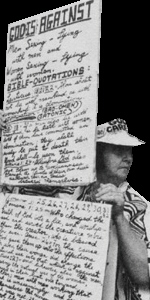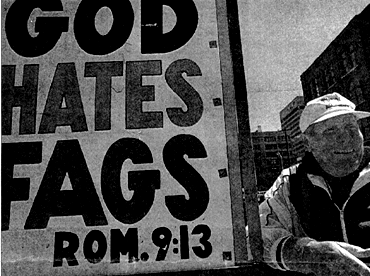 |

|
 Expressions Expressions of Hatred or of Perceived Cultural Norms? Psychologists Examine Aggressive Anti-Gay Motivations |
| Compiled by Badpuppy's GayToday From American Psychological Association Reports
Dr. Franklin addressed at the 106th Annual Convention of the American Psychological Association (APA) in San Francisco (August 14-18). The American Psychological Association is the largest scientific and professional organization representing psychology in the United States and in the world. Dr. Franklin noted that assaults prosecuted under hate crimes statutes ''are only the extreme end of a continuum'' of bias against those perceived as ''gender-deviant.'' In a study of approximately 500 young adults in the greater San Francisco Bay Area, Dr. Franklin found that one in ten respondents admitted to physical violence or threats against people they believed were homosexual. Another 24 percent reported anti-gay namecalling. Among male respondents, Dr. Franklin notes, the rate of perpetration was significantly higher: 18 percent for physical violence or threats and 32 percent for namecalling. ''In other words, half of all young men admitted to some form of anti-gay aggression.'' Meanwhile a third of those who said they had not engaged in anti-gay aggression reported that they would likely assault or harass a homosexual who flirted with or propositioned them. Dr. Franklin has identified four distinct motivations for bias crimes against sexual minorities. Self-Defense assailants, she says, ''appear to interpret their victims' words and actions based on their belief that homosexuals are sexual predators, and typically believe they are defending themselves from aggressive sexual propositions.'' In contract, Ideology assailants ''view themselves as social norms enforcers who are punishing homosexuals for moral transgressions.'' They object not so much to homosexuality itself, Dr. Franklin says, ''but to visible challenges to gender norms, such as male effeminacy or public flaunting of sexual deviance.''
Peer Dynamics assailants, on the other hand, ''commit assaults to prove their toughness and heterosexuality to friends.'' Both types of assailants, she says, minimize their personal antagonism toward homosexuals, and either blame their friends for assaults or minimize the level of harm done. In fact, Dr. Franklin says, her research suggests that most young people who harass, bully and assault sexual minorities do not fit the stereotype of the hate-filled extremist. ''Rather,'' she says, ''they are average young people who often do not see anything wrong with their behavior.'' Meanwhile, researchers Peter S. Theodore of Rutgers University and Susan A. Basow, Ph.D., of Lafayette College, are presenting a study of 74 college males on the link between heterosexual masculinity and homophobia. They found that college-aged men in their late adolescence and early adult years ''who define themselves and their masculinity according to societal standards, are likely to hold homophobic attitudes towards gay men as a means toward reconciling their own feelings of gender inadequacy.'' In other words, homophobia "may represent as much a reaction to the self as it does to gays, lesbians and bisexuals." |
 San Francisco - One of the most widespread forms of bias crime
among teenagers and young adults --violence against sexual minorities --is
rarely motivated by genuine hatred, but is instead ''an expression of
cultural norms that are entrenched even among preadolescent children,''
says forensic psychologist Karen Franklin, Ph.D., of Tacoma, Washington.
San Francisco - One of the most widespread forms of bias crime
among teenagers and young adults --violence against sexual minorities --is
rarely motivated by genuine hatred, but is instead ''an expression of
cultural norms that are entrenched even among preadolescent children,''
says forensic psychologist Karen Franklin, Ph.D., of Tacoma, Washington.
 Hall-of-Fame Homophobe the Rev. Fred Phelps
Hall-of-Fame Homophobe the Rev. Fred Phelps 